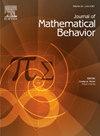学生对等效变换的有效运用
IF 1.7
Q3 EDUCATION & EDUCATIONAL RESEARCH
引用次数: 0
摘要
等效变换——即产生与原对象相等的对象的变换——是K-16数学中统一的概念线索。虽然研究人员已经确立了等价转换的有效推理取决于转换后的对象与给定对象等效的意识,但研究(a)尚未探索学生可能关注等价的各种方式,(b)主要研究了一种类型对象上的等价转换。留下了一个开放性的问题,即在学生对多种类型对象的转换进行推理时,可能存在哪些共性。在本研究中,我们对大学生的任务型临床访谈进行了分析。本文对文献的主要贡献包括描述和说明三种常见的、统一的方式,学生们有效地推理了他们用变换产生的对象的等价性。我们的研究结果扩展了现有等效框架的理论范围,并表明这些推理方式可以帮助学生克服他们所经历的广泛报道的困难。最后,我们讨论了K-16数学等价变换研究的理论意义。本文章由计算机程序翻译,如有差异,请以英文原文为准。
Students’ productive use of equivalence transformations
Equivalence transformations – that is, transformations that produce an object that is equivalent to the original – are a unifying conceptual thread in K-16 mathematics. Though researchers have already established that productive reasoning about equivalence transformations hinges on an awareness that the transformed objects are equivalent to the given object, research (a) has not yet explored the various ways in which students might attend to equivalence, and (b) has primarily examined equivalence transformations on only one type of object, leaving open the question of what commonalities might be present in students’ reasoning across transformations of multiple types of objects. In this study, we present our analysis of task-based clinical interviews with university students. This paper’s primary contribution to the literature involves the description and illustration of three common, unified ways in the students productively reasoned about the equivalence of the objects they produced with transformations. Our findings extend the theoretical scope of an existing equivalence framework and suggest that these ways of reasoning can inform efforts to help students overcome the widespread reports of difficulties they experience. We conclude with a discussion of the theoretical implications for research on equivalence transformations across K-16 mathematics.
求助全文
通过发布文献求助,成功后即可免费获取论文全文。
去求助
来源期刊

Journal of Mathematical Behavior
EDUCATION & EDUCATIONAL RESEARCH-
CiteScore
2.70
自引率
17.60%
发文量
69
期刊介绍:
The Journal of Mathematical Behavior solicits original research on the learning and teaching of mathematics. We are interested especially in basic research, research that aims to clarify, in detail and depth, how mathematical ideas develop in learners. Over three decades, our experience confirms a founding premise of this journal: that mathematical thinking, hence mathematics learning as a social enterprise, is special. It is special because mathematics is special, both logically and psychologically. Logically, through the way that mathematical ideas and methods have been built, refined and organized for centuries across a range of cultures; and psychologically, through the variety of ways people today, in many walks of life, make sense of mathematics, develop it, make it their own.
 求助内容:
求助内容: 应助结果提醒方式:
应助结果提醒方式:


